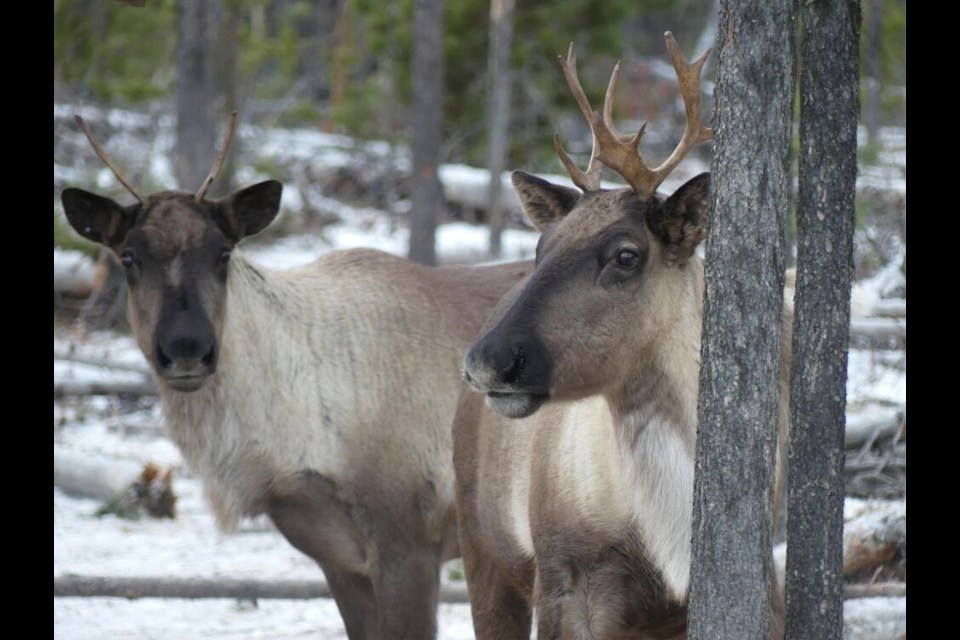The B.C. government is subsidizing oil and gas drilling across a swathe of critical caribou territory it promised to protect, new research has found.
The University of British Columbia study used government data obtained in a freedom-of-information request to map nearly 12,000 active oil and gas wells across the province. Over a quarter of those were found within federally designated critical caribou habitat for two of the most threatened woodland caribou populations. And of those, more than half were run by companies that received provincial royalties over the past three years.
Their conclusion: “Public funds are subsidizing caribou extinction.”
“The main reason behind caribou decline is industrial habitat disturbance,” says lead researcher Adriana DiSilvestro. “Obviously, companies cut roads, but they also cut things called seismic lines to locate (oil and gas) reserves. And when they do that, they create lines of sight for wolves.”
Those seismic lines also act like forest highways, a path for wolves to hunt down already threatened caribou.
That industrial disruption in predator-prey dynamics has led some First Nations to round up pregnant caribou in pens in an effort to breed them. It’s also prompted one of the most controversial wildlife programs in the province: the wolf cull.
Of B.C.’s 53 caribou herds, half are shrinking or have disappeared entirely. The B.C. government says their population has declined from an estimated 45,000 to 15,000 over the past century.
DiSilvestro says the number of oil and gas wells backed by provincial royalties and overlapping caribou territory raises serious questions over the B.C. government’s commitment to conserving the species.
In February 2020, the province, federal government and two First Nations signed two conservation agreements to protect southern mountain caribou populations under Section 11 of the federal Species at Risk Act, which include commitments to protect and restore habitat. The deal was seen as an alternative to a federal government-imposed “emergency order” under Section 80 of the act, something multiple environmental groups had requested.
“The principle of critical habitat is that it's deemed as the habitat necessary for endangered species to recover,” says DiSilvestro, “and the fact that there's oil and gas actively being subsidized on it is really contradictory to a lot of the conservation goals that B.C. has with regard to caribou.”
FUTURE OF OIL AND GAS SUBSIDIES
The amount of money funnelled through British Columbia’s oil and gas royalty credit programs is scheduled to grow. The Deep Well Royalty Credit, which helps cover drilling costs and is the largest royalty program in the province, is forecast to climb to $657 million in 2024, a 56 per cent jump from 2020-21, according to the British Columbia Budget and Fiscal Plan.
According to DiSilvestro’s research, fossil fuel companies are increasingly failing to collect their royalties, leaving the B.C. government with $3.2 billion of outstanding liability.
“This means that royalty payments from oil and gas companies will remain discounted until that $3.2 billion is paid out in future years,” noted the researchers.
In an email to Glacier Media, a spokesperson for the Ministry of Energy, Mines and Low Carbon Innovation said the province is working with First Nations, local governments and industry to “identify acceptable outcomes for caribou recovery as well as continued resource development in B.C.”
The province, said spokesperson Meghan McRae, is currently reviewing B.C.’s oil and gas royalty system to ensure that it meets the province’s economic and environmental goals.
“Many of these royalty credit programs were set up by the B.C. Liberals nearly two decades ago, who never undertook a proper review,” wrote McRae.
She added: “The province’s royalty review will be launched in the coming weeks and will include an independent expert assessment, discussion paper, and full public consultation process.”
Beyond the plight of B.C.’s caribou, DiSilvestro says her research team came against some worrying barriers to transparency, especially when accessing data around the oil and gas industry. More worrying, says DiSilvestro, the B.C. government is still without its own endangered species legislation.
“You have this habitat that needs to be protected, but there's no way to do it,” she says.
A spokesperson for the Ministry of Environment and Climate Change Strategy said it is working with its federal counterpart to better align species approaches to species at risk.
“As the Species at Risk Act (SARA) is a federal legislation, B.C. does not enforce SARA; however, the province works with Canada, local Indigenous communities and local governments to put in place measures to recover species at risk, such as boreal caribou,” said Rob Duffus in an email.
Duffus added that the province is working on “broader provincial approaches and policy tools to achieve positive outcomes for biodiversity and species recovery,” including “consideration of legislative options.”
With files from the Canadian Press





